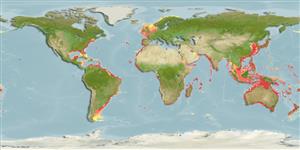Common names from other countries
Environment: milieu / climate zone / depth range / distribution range
Écologie
; profondeur 3 - 120 m (Ref. 81749). Tropical
Circumglobal.
Length at first maturity / Taille / Poids / Âge
Maturity: Lm ? range ? - ? cm
Epibiotic (Ref. 111011). Occurs in subtidal and low tide areas, and it usually covers bare rocks. Found on a dead branch of A. wollastoni (Ref. 2767). Part of fouling communities attached to raft frames in mariculture zones (Ref. 127121).
Life cycle and mating behavior
Maturité | Reproduction | Frai | Œufs | Fécondité | Larves
Members of the superorder Thoracica are mostly hermaphroditic. Broadcast spawners, fertilization occurs in the mantle cavity. Life cycle: Eggs hatch into planktonic nauplii and leave the mantle cavity. Afterwards, they undergo six naupliar instars succeded by nonfeeding cypris larva (settling stage) which later metamorphose into adults.
Young, P.S. 1998. (Ref. 3549)
Statut dans la liste rouge de l'IUCN (Ref. 130435)
statut CITES (Ref. 108899)
Not Evaluated
Not Evaluated
Utilisations par l'homme
| FishSource |
Outils
Plus d'informations
Taille/Âge
Croissance
Longueur-poids
Longueur-longueur
Morphologie
Larves
Abondance
Sources Internet
Estimates based on models
Preferred temperature
(Ref.
115969): 17 - 28.2, mean 26.1 (based on 1668 cells).
Catégorie de prix
Unknown.
